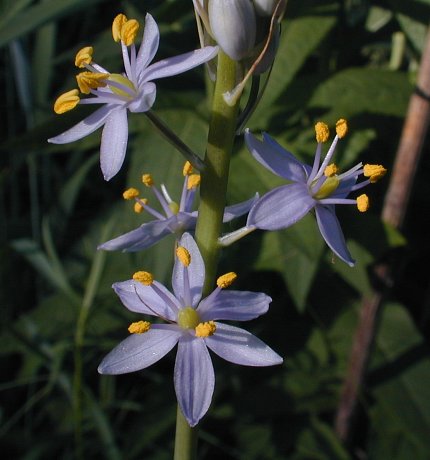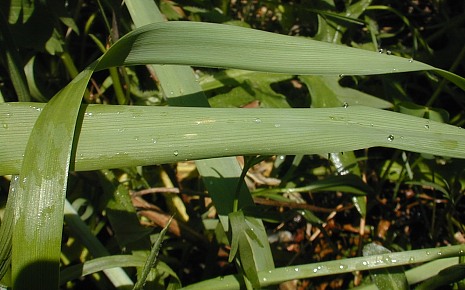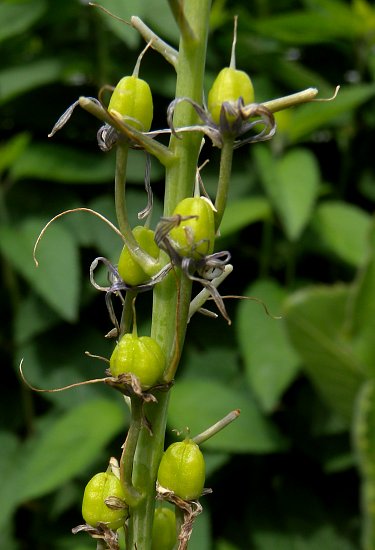Description: This perennial plant consists of a rosette of basal leaves up to 1½' across and one or more flowering stalks up to 2½' tall. The strap-shaped basal leaves are up to 14" long and 1" across; they are linear, smooth along the margins, and glabrous. Their veins are parallel. These basal leaves are rather floppy and they often arch downward or sprawl across the ground in the absence of support from other vegetation. The basal leaves wither away by mid-summer. The flowering stalks are erect, slender, hairless, and leafless. Each stalk terminates in a raceme of about 20-80 flowers. Each flower consists of 6 lavender to pale blue-violet tepals, 6 stamens with golden yellow anthers, and a light green pistil with a short slender style. Each flower spans about ¾" across when it is fully open. The pedicels of the flowers are slender, green, and deciduous, unless the flower is successfully cross-pollinated. Underneath each flower, there is often a persistent bract about ¾" long that is thread-like in appearance.

After
the flowers begin blooming on the raceme, there can be 3-20 (or more)
of these bracts underneath. Several flowers bloom in a ring at the same
time, which forms at the bottom of the raceme and moves upward. The
blooming period occurs from late spring to early summer and can last up
to 1 month for a colony of plants. The flowers that are successfully
cross-pollinated form seed capsules that are ovoid-oblongoid in shape.
Each capsule contains several seeds. The root system consists of a bulb
with secondary fibrous roots at the bottom. This plant reproduces by
forming offsets from the bulbs and by reseeding itself.
Cultivation:
The
preference is full or partial sun, moist to mesic conditions, and a
fertile loamy soil. This plant is rarely bothered by disease and insect
pests. It is somewhat slow to develop, especially from seeds.

Range &
Habitat:
In Illinois, Prairie Hyacinth is a rare plant that has been observed in
Macon and
Peoria counties only (see Distribution
Map). At the present time, only one population of plants is
known to exist within the state at a railroad prairie. Apparently, the
other population has been extirpated. In neighboring states, Prairie
Hyacinth has been observed in prairies and thinly-wooded areas. This
native
species is state-listed as 'endangered' in Illinois.
Faunal Associations:
The flowers attract both long-tongued and short-tongued bees, which
suck nectar or collect pollen. Other visitors of the flowers include
various flies, butterflies, skippers, wasps, and beetles, which suck
nectar or feed on pollen. Aside from these flower-visiting insects,
little information is available about floral-faunal relations for this
wildflower.
Photographic
Location:
The webmaster's wildflower garden in Urbana, Illinois.

Comments: This little-known species is sometimes confused with Camassia scilloides (Wild Hyacinth), which is more common within the state. Both species are attractive wildflowers with similar habitat preferences. Their appearance is quite similar, which can make them difficult to tell apart. Prairie Hyacinth begins to flower about a month later than Wild Hyacinth and there is little overlap in their blooming periods; this is one good reason why they should be considered separate species. The flowering stalk of Prairie Hyacinth has 3-20 (or more) persistent bracts underneath the blooming flowers, while Wild Hyacinth has 0-2 deciduous bracts underneath the flowers of its stalks. The seed capsules of Prairie Hyacinth are longer than they are wide, while the seed capsules of Wild Hyacinth are about as long as they are wide. The flowers of Prairie Hyacinth tend to have shorter styles, shorter stamens, and tepals that are a little shorter and more deeply colored, but these distinctions are less reliable, or they require the careful use of a ruler or measuring tape in the field.